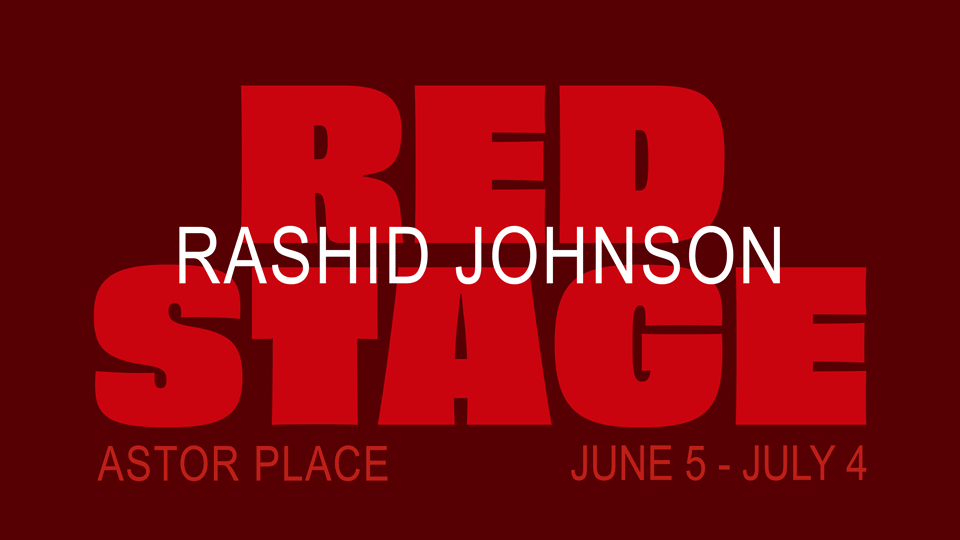CURATORIAL STATEMENT
For you.
Amidst an ongoing global pandemic and multiple human rights crises that have kept the world in isolation and grief, Rashid Johnson’s Red Stage is an emergency call to artists and creatives to experiment, collaborate, and gather in an act of resurgence. The minimalist sculpture — akin to a bandshell stage — is rendered in steel and powder-coated in a color Johnson describes as “alarm red.” Its simplicity is imbued with life: the entirety of the surface is marked by Johnson’s hand and the structure holds a vibrancy of thriving living plants. Stewarding this work requires a commitment to engender and nurture life-affirming futures.
Red Stage acts as an armature or infrastructure for cultural context and engagement, much like the artist’s previous sculptures Antoine’s Organ (2016), and more recently Stage (2020). It is a literal and metaphorical support for the open-ended, spontaneous creation of artists. Using the material language of the city, the hard structure juxtaposes with the organic improvisation and experimentation it invites. In the spirit of abundant possibility, and in the lineage of the Hyde Park Speakers’ Corner¹, improvised soapboxes², and a long history of buskers and street performers in New York City, Johnson’s sculpture is intended to be an open stage for artists and makers of all kinds to move, speak, and play freely. This simple gesture actually sits atop a complex web of invisible municipal bureaucracy, pointing to the barriers enacted to regulate and often criminalize public performance and assembly.
Situated within Astor Place, a historic geographic intersection of congregation and contestation, Red Stage revives the intersections of performance and protest. Known prior to settler colonialism as “Kintecoying,” or “Crossroads of Three Nations,” Astor Place today is considered the space where the East and West Villages meet. It is at this crossroads where tensions play out, rules are contested, and new ideas and organizations form. The brutal Astor Place Riot and infamous Folk Riots just to the East in Washington Square Park remind us that performance has been both a symbol for class conflict and a site for racialized policing and targeting a political left. Numerous seeds of rebellion have fomented in Astor Place throughout its history: from Frederick Douglas’ 1863 Delivery of “The Proclamation and a Negro Army” address at Cooper Union, a scathing indictment of the North’s hypocritical embroilments in the slave economy, to the formation of avant-garde educational centers for socialist and anarchist ideas, the Chinese Students Alliance’s dissent against China’s actions in the Sino-Soviet war and most recently, the 2020 Black Lives Matter protests.
Rooted in these histories and reflecting on our contemporary moment of uprooting intersectional inequities, artists and thinkers have been invited to Red Stage to use public space to seed reparative practices. Throughout the installation, the stage will host performances on declarations of resurgence, conversations with poets and organizers on public assembly, apothecary workshops on collective remedy, protest music in a lineage of call and response, joyful civic actions, and multigenerational play. Of course, the plaza’s usual skaters and diners, daydreamers and readers, corner preachers and saxophone players are sure to pass through and join in. Those activating the platform are asked, what are the imperatives of this moment we survive? How do they call us to gather?
As the world unevenly experiences the impact of Covid-19, and New York City begins to economically and socially reawaken, Red Stage affords us the opportunity to come together in this complexity to question the idea for a new normal and to envision the potential of truly engaging in public space. For the month of June, Red Stage establishes a temporary public-led public space for artists, organizers, and agitators. It is a proposition to the public to occupy space through movement – activation of the body in dance, the breath in song, the fist in protest, and the collective in revolutionary potential.
– Diya Vij
New York City
June 2021
¹ https://www.royalparks.org.uk/parks/hyde-park/things-to-see-and-do/speakers-corner
² A soapbox is an informal raised platform or wooden crate used for impromptu street corner speeches, most often political in nature. While soapboxes can be found throughout history and into present day, they are often associated with the decades surrounding World War I.
Lead project support for Red Stage is provided by Max and Monique Burger, Burger Collection Hong Kong; Molly Gochman; The O’Grady Foundation; and an anonymous donor. Red Stage is also supported in part by an award from the National Endowment for the Arts. The project would not have been possible without site support and collaboration from the NYC Department of Transportation’s Temporary Art Program (DOT Art) and the Village Alliance.
Major Creative Time programming support for 2021 has been generously provided by Arison Arts Foundation, the Charina Endowment Fund, The David Teiger Foundation, the Destina Foundation, The Helen Frankenthaler Foundation, the Henry Luce Foundation, the Horace W. Goldsmith Foundation, The Lambent Foundation Fund of Tides Foundation, the Laurie M. Tisch Illumination Fund, Open Society Foundations, the Stavros Niarchos Foundation, and The Willem de Kooning Foundation. We are also grateful for the support of the National Endowment for the Arts (NEA); public funds from the New York City Department of Cultural Affairs (DCA) in partnership with the City Council; and the New York State Council on the Arts (NYSCA) with the support of Governor Andrew M. Cuomo and the New York State Legislature.



